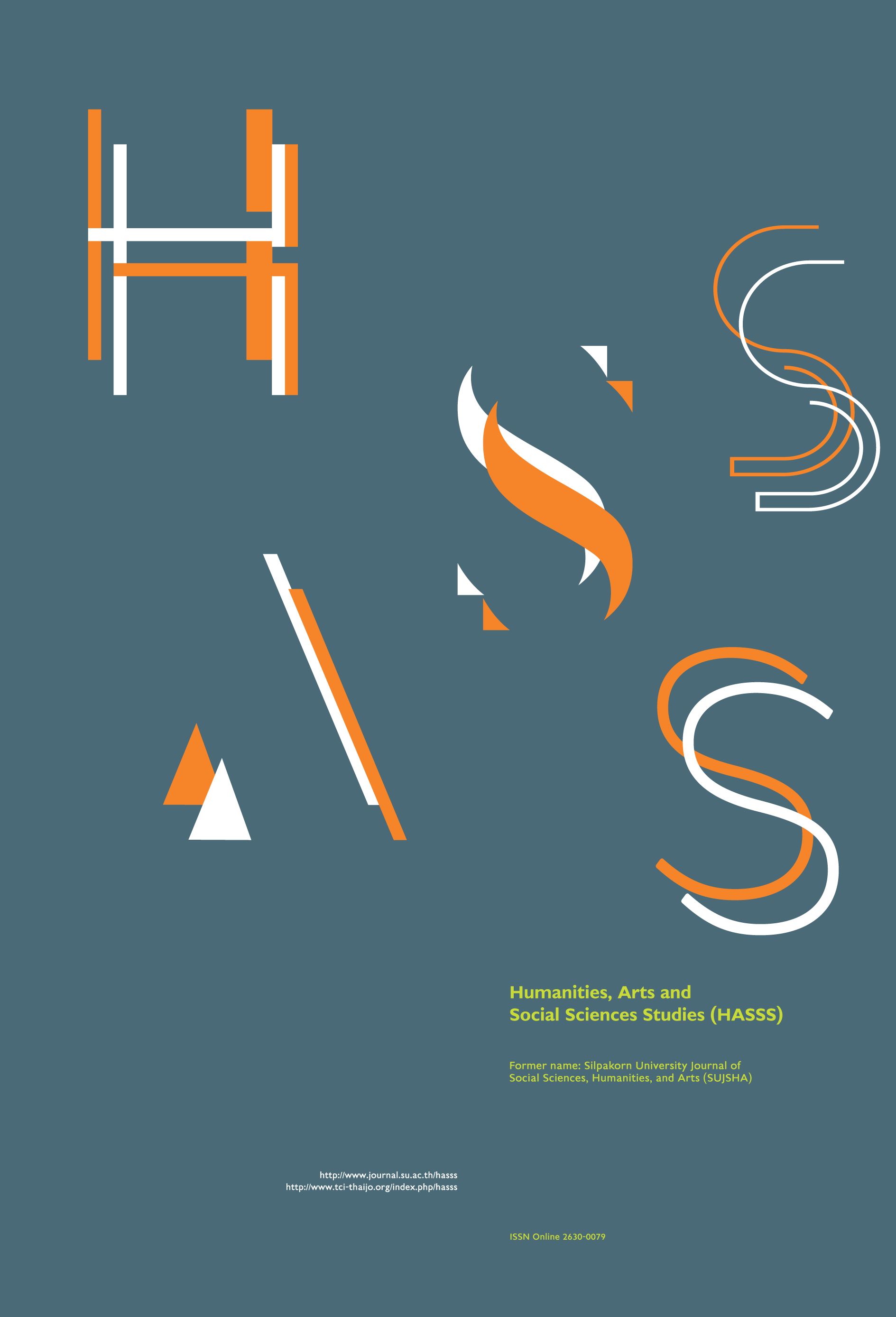San Somdet and the knowledge formation of Thai art history in Thailand
Main Article Content
Abstract
This research intends to analyze the informing methods of Thai Art Historical knowledge from “San Somdet”, a compilation of letters by Prince Narisara Nuvadtivongs and Prince Damrong Rajanubhab. Both princes held prestige positions in Thai bureaucracy during the reigns of King Rama V-VII. Shortly after the shift of ruling regime in Siam, Prince Damrong left Thailand and stayed in Penang. However, he regularly wrote letters to Prince Naris. Later, these letters were compiled and published as “San Somdet”. This compilation is acclaimed as a highly historically valued document because its content covers historical, social and cultural knowledge of Siam in that time. This research proposes a new perspective that both princes use systematic, western scientific methods, which has never been studied before, in the process of informing Thai arts and historical knowledge. Those methods are: 1) inquiry and examination information from both princes’ memories and others scholars, 2) research from written documents, 3) examination from different sources, 4) data collection from field exploration, 5) analysis based on scientific tool and experiment, and 6) dating by comparison between artifacts’ patterns and materials. Although these methods are not considered an exact criterion in the current Art History’s methodology, these attempts show the transition of knowledge formation of Thai Art History. The knowledge taken from San Somdet is still resourceful to Thai academics until today.
Downloads
Article Details
All rights reserved. Apart from citations for the purposes of research, private study, or criticism and review,no part of this publication may be reproduced, stored or transmitted in any other form without prior written permission by the publisher.
References
Bunnag, P. (2006). Political Sciences and History Multidisciplinary in Political Science. Nontaburi: Sukhothaithammatirat University. [in Thai]
Diskul, P., Momchao. (1963). Speeches about Prince Damrong and His Biography as Told by His Children. Phranakon: Kurusapha. [in Thai]
Diskul, S., Momchao. (1983). The Identification of Archaeological period by using patterns’ evolution Researches in Humanities and Arts: Thai Scholars’ Views. Bangkok: Chulalongkorn University Press. [in Thai]
Johnson, W. and Janson, F. (1992). A Basic History of Art. New York: Prentice Hall.
Khrouthongkhieo, N. (2015). The reflection of Thai society in Thai art history’s method. Ramkhamhang Humanities Journal 34(2): 111-130.
Krairiksh, P. (1990). History and archaeology in Thailand. Bangkok: Amarin Printing Group. [in Thai]
Fine Art Department. (2004). Collections of Thai Inscriptions Vol. 8: Sukhothai Inscription. Bangkok: Amarin Printing and Publishing, Ltd. [in Thai]
Matichon. (2016). Have You Seen It? The Sketches of the Painting, Ramayana, Before Painting at Wat Phra Keaw. “Prince Naris'' Noticed That There Was a Weirdness in Itself. [Online URL: https://www.matichon .co.th/entertainment/arts-culture/news_200930] accessed on August 24, 2019. [in Thai]
Monkut Klao Chao Yu Hua, His Majesty King. (1983). Travel in Ancient City of Phraruang. Bangkok: Kurusapha. [in Thai]
Narisara Nuvadtivongs, Prince and Damrong Rajanubhab, Prince. (1962). San Somdet [Correspondence Between Two Princes] (Vols. 2, 3, 5, 8, 10-13, 15, 16, 18, 22, 23, 26). Phranakon: Kurusapha. [in Thai]
Panofsky, E. (1974). Meaning in the Visuals Arts. New York: The Overlook press.
Peleggi, M. (2015). The plot of Thai history: Buddhist sculpture and the myth of national origins. In A Sarong for Clio: Essays on the Intellectual and Cultural History of Thailand--Inspired by Craig Rynolds, edited by M. Peleggi, pp. 79-96. New York: Cornell University.
Phra Rattana Panyathera. (2007). Shinnakanmalipakorn (Saeng M., Trans.). Bangkok: Ramthai Place.
Poshyananda, A. (1993). Western-Style Painting and Sculpture in the Thai Royal Court. Bangkok: Bureau of the Royal Household. [in Thai]
Prakitnontakarn, C. (2017). Writings of early art history and the construction of the absolute state of Siam. Najua Magazine 14: 86-121. [in Thai]
Right, M. (2001). Questions of Art History, Evidence and Hypothesis, Tastes and Politics. Silpawattanatham Magazine 22(6): 72-75. [in Thai]
Sahai, S. (2003). King Chulalongkorn traveled in India, India in 1872: As Seen by the Siamese (K. Sriudom, Trans.). Bangkok: Social Sciences and Humanities Project Textbook Foundation. [in Thai]
Sukhasvasti, S., M. R. (1992). Buddha Image in the Grand Palace. Bangkok: Royal secretary. [in Thai]
The Royal Society. (2013). The Royal Society’s Dictionary B.E. 2554. Bangkok: Practical Design Studio.
Thammarungrueang, R. (2008). Histories, Approaches and Research Methods in Thai Art History. Bangkok: Muangboran. [in Thai]


